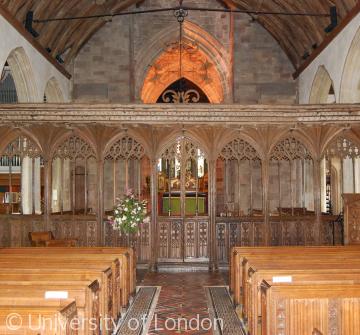Church Furnishings and Monuments
 The carved rood screen in the church of St George, Dunster, dates from the late 15th century and is the longest in England
The carved rood screen in the church of St George, Dunster, dates from the late 15th century and is the longest in EnglandMost medieval churches have lost many or all of their contemporary furnishings. The appearance of the interior of a medieval church varied, of course, from period to period and according to whether it had wealthy patrons or not. Most surviving church furnishings were installed in the 14th century and after. By that time almost all churches were colourful, with wall paintings and stained glass, and full of fixed and moveable items, such as side altars, screens, statuary, and tombs.
Fonts are often the earliest items and may predate the building they are in. Although a few have been moved from other churches, most give a clue to the origins of the church as the grant of the right to baptise was an important milestone in establishing a parish church. Other early furnishings, because of stone and part of the church building, are piscinae (where the communion vessels were washed) and sedile (seats for the clergy); they are always associated with altars and so mark where they stood, even when the altars themselves have gone. A Norman font and 13th-century piscine can be seen at West Anstey on Exmoor. Some stone pulpits survive but many were removed when church interiors were reorganised after the Reformation.
Most remaining furnishings were crafted from wood. Most prominent are screens which enclosed the spaces round altars. Those dividing chancel and nave were designed to obscure the congregation’s view of the celebration of the Eucharist by the priest, thereby making the ceremony more sacred and mysterious. Screens erected in the 14th and 15th centuries were elaborate with traceried openings and a superstructure (loft) from which parts of the service could be sung.
The late medieval church had a rood screen which in many cases ran across the full width of the church, dividing the nave and the chancel and its flanking chapels; this provided a less confined view of the east end than an arch in a stone dividing wall. The name, rood screen, came from the image of the Christ on the Cross which stood on the centre of the screen or hung above it. Many survive in Cornish churches, for example at St Ewe. Those churches also contain a large number of bench ends, fancifully carved like that at St Nonna’s church in Altarnun. Benches became common in the 15th- and 16th-century churches to seat a congregation with higher expectations of comfort in all aspects of their lives. Some churches also retain late medieval stalls used by choir and clergy in the chancel. Although late medieval timber roofs are not furnishings, they display the similar craftsmanship and add another decorative dimension to the church, as fine wagon roofs with carved bosses on Exmoor and in Cornwall show.
The Reformation and later the English Civil War saw many medieval furnishings removed or destroyed. Protestant worship changed the emphasis of church services from a celebration of the Eucharist (or mass) to preaching. Pulpits became the focus of the church and a moveable table was used for communion rather than a stone altar. The colour and mystery of a medieval church were dispelled: screens were removed, clear glass replaced stained glass and wall paintings were whitewashed over as a background for biblical texts. The desire for comfort grew. Enclosed box or gated pews were installed, and landowners often had their own, sometimes with fireplaces. Open timber roofs were ceiled in and walls were panelled.
It was not until the 1840s that movement to reinvigorate the church by inspiration from its medieval past led not only to the restoration of medieval churches and the building of new ones in medieval styles but the refurnishing of church interiors. Additional seating - and particularly free seating - was required for the expanding Victorian population and many churches were repewed with benches in versions of medieval ones. Chancels were refurnished with choir stalls and stone altars, screens were erected and towering three-decker pulpits replaced or cut down.Since World War 2 many church interiors have been reorganised to involve the congregation more fully in the service. Altars have been brought forward and social spaces have been created, often by the removal of fixed Victorian pews.
The 16th and 17th centuries also saw the destruction of many funerary monuments, particularly large ones standing in prominent and sometimes obstructive positions. Unidentified fragments and effigies from these often survive, relegated to out-of-the-way corners of naves and aisles. It is interesting to trace sequences of family monuments, from medieval canopied tombs and free-standing tomb chests to elaborate wall monuments made in the 16th, 17th and 18th centuries and simpler Georgian and Victorian wall tablets. Most parishioners were buried, not in the church or in family burial vaults below it, but in the churchyard, where tombs and inscriptions provide visual and inscribed information about local people, their connections and their occupations.









